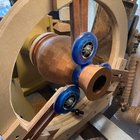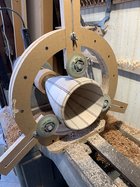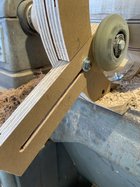Planning to construct a steady rest this weekend out of ¾” plywood. I’ve watched several videos and have determined how I will construct it.
The ring itself will be 2” wide and two layers of ¾” plywood laminated together. The plan is to trim the bottom of the ring so that the capacity through the rest is maximized. Seems best case is losing ¾” at the bottom of the circle to allow laminated to a base plate for sufficient strength over the ways.
My main question concerns the inner diameter of the ring itself. The lathe is a 12” model, and I’d like to maximize the capacity of the rest. My gut says that the minimum opening should be a 12” diameter, which means the outside diameter needs to be 16”.
Does one also need to account for any space for the wheels and their mounting? The goal is to ensure that it will allow for a 10” diameter vessel.
Open to thoughts on what you would do differently in making one of these.
The ring itself will be 2” wide and two layers of ¾” plywood laminated together. The plan is to trim the bottom of the ring so that the capacity through the rest is maximized. Seems best case is losing ¾” at the bottom of the circle to allow laminated to a base plate for sufficient strength over the ways.
My main question concerns the inner diameter of the ring itself. The lathe is a 12” model, and I’d like to maximize the capacity of the rest. My gut says that the minimum opening should be a 12” diameter, which means the outside diameter needs to be 16”.
Does one also need to account for any space for the wheels and their mounting? The goal is to ensure that it will allow for a 10” diameter vessel.
Open to thoughts on what you would do differently in making one of these.



